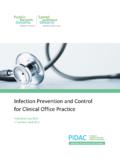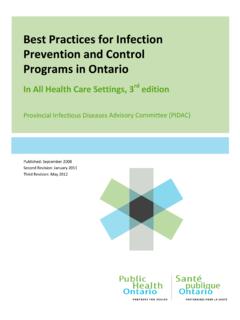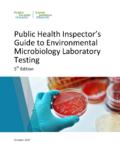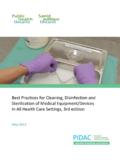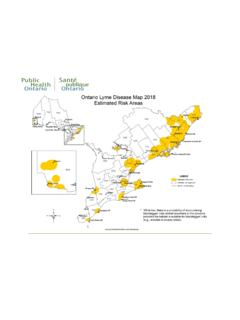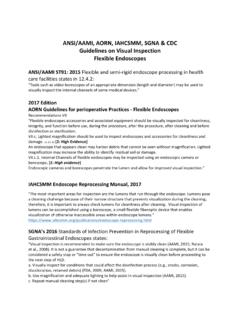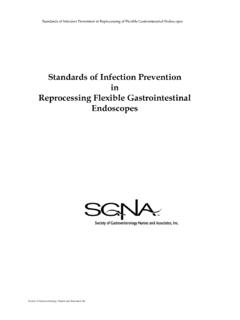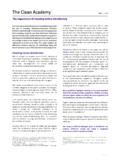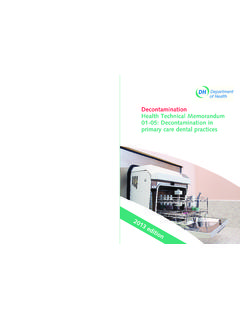Transcription of Checklist for Endoscopy in Clinical Office Practice
1 2nd Revision: July 2019 IPAC Checklist For Clinical Office Practice Endoscopy 1 IPAC Checklist FOR Clinical Office Practice Endoscopy When to use this Checklist ? This infection prevention and control (IPAC) Checklist : helps guide public health units (PHUs) and regulatory colleges in conducting inspections/assessments/ investigations related to infection prevention and control (IPAC) practices. supports Clinical Office practices in examining, evaluating ( , self-assessment) and comparing their current IPAC practices using provincial recommendations. does not replace legislative requirements. Public Health Ontario (PHO) has developed this Checklist for Endoscopy in Clinical Office Practice based on content from the Provincial Infectious Disease Advisory Committee s (PIDAC) Best Practices for Cleaning, Disinfection and Sterilization of Medical Equipment/Devices.
2 For more information about this IPAC Checklist , please contact Legend Legislated Requirement (LR): Must be compliant with the relevant Act or regulation ( , Occupational Health and Safety Act). High Risk (H): Immediate health hazard exists. Correct the specific high risk activity/activities immediately. The act or failure to act immediately may lead to the transmission of infection or risk of illness or injury. Medium Risk (M): Correct the medium risk activity/activities. Timelines for compliance or agreement on alternate process to be determined during the inspection. Inform and Educate (IE): Provide information on best practices and mandatory legislated Practice requirements (where applicable). Just-in-time education may be provided. These categorizations represent the minimum risk level. Based on judgment and circumstance, public health units or any others using the IPAC Checklist may increase the risk category.
3 LR: Legislated Requirement R: Risk C: Compliant NC: Not Compliant NA/NR: Not Applicable/Not Reviewed IPAC Checklist For Clinical Office Practice Endoscopy 2 Types of Endoscopes For the purpose of this Checklist , two types of endoscopes will be considered: Critical Endoscope: Endoscopes used in the examination of critical spaces, such as joints and sterile cavities. Many of these endoscopes are rigid with no lumen. Examples of critical endoscopes are arthroscopes, bronchoscopes and laparoscopes. Critical endoscopes are to be sterilized prior to use (PIDAC CDS, pg 43). Semicritical Endoscope: Fibreoptic or video endoscopes used in the examination of the hollow viscera. These endoscopes generally invade only semicritical spaces, although some of their components might enter tissues or other critical spaces. Examples of semicritical endoscopes are laryngoscopes, nasopharyngeal endoscopes, transesophageal probes, colonoscopes, gastroscopes, duodenoscopes, sigmoidoscopes and enteroscopes.
4 Semicritical endoscopes require a minimum of high-level disinfection prior to use. Opinions differ regarding the reprocessing requirements for flexible bronchoscopes and cystoscopes. Since they are entering a sterile cavity, it is preferred that bronchoscopes and cystoscopes be sterilized; however, if the cystoscope or bronchoscope is not compatible with sterilization, high-level disinfection is the minimum requirement. LR: Legislated Requirement R: Risk C: Compliant NC: Not Compliant NA/NR: Not Applicable/Not Reviewed IPAC Checklist For Clinical Office Practice Endoscopy 3 Contents 1. Policies and Procedures ..4 2. Education ..2 3. Personal Protective Equipment ..3 4. Safe Medication Administration ..3 5. Environmental Cleaning ..5 6. Physical Space ..5 7. Point-of -Care Cleaning ..7 8. Cleaning of Endoscopes in Reprocessing Area.
5 8 9. High Level Disinfection (HLD) ..9 10. Automated Endoscope Reprocessors (AER) .. 11 11. Drying and Storage of Endoscopes .. 12 12. Endoscope Transport .. 13 13. Record Keeping .. 13 14. Occupational Health and Safety .. 15 LR: Legislated Requirement R: Risk C: Compliant NC: Not Compliant NA/NR: Not Applicable/Not Reviewed IPAC Checklist For Clinical Office Practice Endoscopy 4 Setting name: Setting address: Self-Assessment Inspection Date: Time:Name(s) and designation of Inspector/Investigator/Assessor: Setting contact name(s) and phone number(s): 1. Policies and Procedures 1 Policies and Procedures LR R C NC NA NR The purchase of endoscopes that cannot be cleaned and reprocessed according to recommended standards is prohibited; there is a written policy to support this. Resource: Refer to the section on Purchasing and Assessing Medical Equipment/Devices and/or Products for Disinfection or Sterilization Processes.
6 IE There are written, detailed device-specific procedures for the handling (including disassembly and reassembly), cleaning, and disinfection/ sterilization of each type of endoscope and accessories that follow the manufacturer s instructions for use (MIFU). Resource: Refer to the section on Reprocessing Endoscopy Equipment/Devices Additional. Additional Resource: CAN/CSA Z314-18 Canadian medical device reprocessing (2018). IE There are written procedures and MIFU for the use of automated endoscope reprocessors (AERs), sterilizers or other equipment used in reprocessing. Resource: Refer to CAN/CSA Z314-18 Canadian medical device reprocessing (2018). IE LR: Legislated Requirement R: Risk C: Compliant NC: Not Compliant NA/NR: Not Applicable/Not Reviewed IPAC Checklist For Clinical Office Practice Endoscopy 2 Section 1 - Notes and Recommendations: 2.
7 Education 2 Education LR R C NC NA NR Staff assigned to reprocess endoscopes receive device-specific reprocessing instructions to ensure proper cleaning and high-level disinfection or sterilization; education includes theoretical and practical components. Resource: For & , refer to the section on Reprocessing Endoscopy Equipment/Devices. Additional Resource: CAN/CSA Z314-18 Canadian medical device reprocessing (2018). M Competency testing of personnel reprocessing endoscopes is performed at least annually and documented. M Staff involved in reprocessing are trained in the correct use, wearing, limitations, and indications for PPE. Resource: Refer to the section on Occupational Health and Safety for Reprocessing: Personal Protective Equipment (PPE). M Section 2 - Notes and Recommendations: LR: Legislated Requirement R: Risk C: Compliant NC: Not Compliant NA/NR: Not Applicable/Not Reviewed IPAC Checklist For Clinical Office Practice Endoscopy 3 3.
8 Personal Protective Equipment 3 Personal Protective Equipment (PPE) LR R C NC NA NR PPE, such as gown, gloves, mask, and eye protection, is available. Resource: For and , refer to the section on Occupational Health and Safety for Reprocessing: Personal Protective Equipment (PPE). Additional Resource: Occupational Health and Safety Act, RSO 1990, c , LR M PPE (gloves, gown, mask, eye protection) is worn during a procedure and during reprocessing activities ( , endoscope cleaning) that are likely to result in splashes or sprays of blood or other body fluids. Resource: Occupational Health and Safety Act, RSO 1990, c , LR M Section 3 - Notes and Recommendations: 4. Safe Medication Administration 4 Safe Medication Administration LR R C NC NA NR There are facilities for hand hygiene in the medication room/area. These include either a dedicated hand hygiene sink and/or alcohol based hand rub (ABHR).
9 Resources: For to , refer to PIDAC Infection Prevention and Control for Clinical Office Practice (April 2015). See sections on Medications, Vaccines and Skin Antisepsis, and Appendix H: Checklist for Safe Medication Practices. M There is a dedicated medication refrigerator as needed ( , vaccine). M LR: Legislated Requirement R: Risk C: Compliant NC: Not Compliant NA/NR: Not Applicable/Not Reviewed IPAC Checklist For Clinical Office Practice Endoscopy 4 4 Safe Medication Administration LR R C NC NA NR Single-dose injectable medications are preferred and prepared at the time of use, used once on a single patient and discarded immediately. H Unopened vials and other products are discarded according to the manufacturer s expiration dates. M If a multidose vial is used, it is to be used for a single patient/client whenever possible and labelled with the patient s/client's name.
10 M The multidose vial is labelled with the date it was first used and discarded according to the MIFU or within 28 days, whichever is shorter. M All needles are single-use only. H All syringes are single-use only. H Once medication is drawn up, the needle is immediately withdrawn from the vial; a needle is never left in a vial to be attached to a new syringe. H Multidose vials are discarded immediately if sterility is compromised or questioned. H Section 4 - Notes and Recommendations: LR: Legislated Requirement R: Risk C: Compliant NC: Not Compliant NA/NR: Not Applicable/Not Reviewed IPAC Checklist For Clinical Office Practice Endoscopy 5 5. Environmental Cleaning 5 Environmental Cleaning LR R C NC NA NR The treatment area and Endoscopy suite are cleaned between patients, after each case and at least twice per day.

